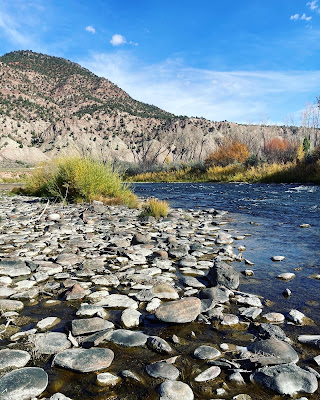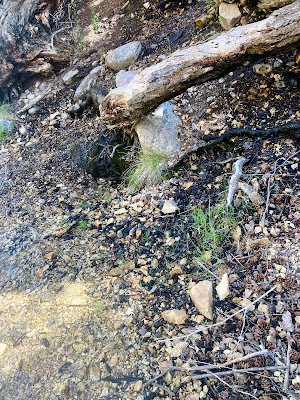 |
| The Eagle River is a beautiful freestone river in Colorado. |
Becoming familiar with the differences of a freestone, a tailwater, and a spring creek can be extremely helpful in preparing for a day of fishing. The nature of these types of rivers holds a healthy population of fish with differences in how they are fished. The distinctiveness of each can be noteworthy in the success of fishing these rivers and creeks.
The wild Freestone fisheries are rivers originating from mother nature’s snowmelt and rainfall. Many freestone trout rivers begin up in the altitudinous mountains where trickles of snowmelt interfuse to create a small creek. The undersized creek will flow down and adjoin with other tributaries to form a grand river.
The more snow the mountains may receive in the winter, the more water is reserved for the runoff and trickle of melt throughout the season. These rivers are consistently changing to the ebb and flows with the grace of mother nature. Warm spring days when snow is melting quickly, freestones will swell quickly and become stained or off-color. During high runoff, they may become unfishable due to raging water flows.
 |
| Freestone rivers are depended upon snowmelt and precipitation. |
Freestones react to frigid temperatures and typically freeze over in the winter, and they become inaccessible. If the snowfall is poor, lower flows can be expected and warmer water. During the hot summer, carrying a thermometer is a good approach in checking water temperature throughout the day. Temperatures can give the angler knowledge of hatches and temperature readings when too warm at 65 degrees and greater, to stop fishing. Hot summer days may require fishing early morning and end by early afternoon and to not fish in the heat of the day. Warm water conditions are stressful for fish with recovery and a higher mortality rate.
 |
| S. Boulder Creek is sourced near Rogers Pass on the Continental Divide. |
The trout in freestone rivers and creeks are survivors through below freezing winters, the fluctuation of flows influenced by melt and precipitation, and varied water temperatures. The trout are eager feeders for nourishment that live in the freestone rivers and creeks. They are not as finicky as those in tailwaters. Nymphing, dry fly, and streamers are effective with abundance of Caddis, Stoneflies, and Pale Morning Dun patterns.
 |
| The Stagecoach Tailwater nestled in Steamboat Springs, Colorado. |
Tailwater fisheries exist solely due to the influence of a dam at the head of the river. These great tailwaters exist with consistent water temperatures that are often drawn from the bottom of the in-river reservoir. Water temperatures and flows are regulated and discharge from the dam. These optimal conditions have a larger concentration of vegetation, organisms, hatches, and sizeable flourishing trout.
 |
| The Blue River is one of my most favorite scenic tailwaters. |
Tailwaters are not at the mercy of mother nature of weather and snowmelt as a freestone. Water temperatures are fairly consistent in the summer and all the other seasons. It usually won’t freeze over during winter which allows for year-round fishing. Many of these tailwaters are gold medal waters.
 |
| The S. Platte River is a favorite tailwater for winter fishing in Colorado. |
Fishing tailwaters typically receive a lot of fishing pressure with the expectation of substantial crowds. There is a consistent high number of small insects for food in tailwaters. These trout are knowledgeable and selective with all the different flies they see. Targeting these trout will require honing in on smaller midges and fishing with fluorocarbon. Other variety of bug life are aquatic worms, small crustaceans such as mysis shrimp, scuds, and sow bugs that are not typically present in freestone rivers.
 |
| Spring creeks exist from the groundwater seepage. |
Spring creeks exist entirely from the groundwater seepage of natural nutrient rich spring water. They are free flowing bodies of water that are fed by an underground aquifer. Water from spring creeks can additionally be nourished by snowmelt or rain, but typically live entirely on their own. These small fisheries can sustain prolific hatches of mayflies and caddis for brown and rainbow trout.
 |
| Spring creeks will seep and create creeks or run into other creeks and rivers. |
Fishing these creeks can be quite difficult with dense vegetation, shallow flows, and crystal clear water. Fish in spring creeks are spooky and very selective of flies. With a stealthy approach, a 3 wt. 8’ 6” fly rod, light tippet, and tiny flies, fishing these little creeks can be a hoot!
Having knowledge of the different types of water from a freestone, a tailwater, or a spring creek with good preparation and tactics will lead for a successful day of fishing. Each have their unique challenges and rewards. See you on the rivers and creeks!
This blog is also at Togens Fly Shop My favorite hooks, beads, threads, and fly tying materials!
 |
| A mountain spring creek. |
Nice blog Cat my favorites, Armstrong spring creek the firehole and the letort in Pennsylvania. Keep it up
ReplyDeleteThank you, Michael. :o) If there is a small creek, I love grabbing my light, creekin rod and trying to catch those little gems!
DeleteWhich is your favorite Spring creek?
ReplyDeleteAlso which creek, stream or river have you found to have prolific and variable dry flys?
I've fished some spring creeks in the higher elevations in the mountains here in Colorado and near Almont. I primarily fish the big rivers. I've enjoyed the best hatches mostly at the tailwaters for dry fly. How about you?
Delete